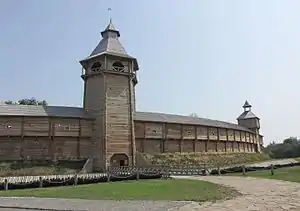Sack of Baturyn
Sack of Baturyn (Ukrainian: Захоплення Батурина, romanized: Zakhoplennia Baturyna, Russian: Взятие Батурина) (October 27 - November 2, 1708), sometimes also referred to as the Slaughter of Baturyn or The Rape of Baturyn, was a part of series of punishing raids conducted by the Russian Imperial Army against Ukrainian Hetman Ivan Mazepa and Cossack state. On 2 November 1708, a Russian army under the command of Menshikov entered the city Baturyn, defeating the garrison, slaughtered the entire civilian population, and burned the city to the ground.
| Sack of Baturyn | |||||||
|---|---|---|---|---|---|---|---|
| Part of the Great Northern War (Mazepa Affair) and the Swedish invasion of Russia | |||||||
 Reconstruction of the Baturyn Citadel | |||||||
| |||||||
| Belligerents | |||||||
|
|
| ||||||
| Commanders and leaders | |||||||
| Colonel Chechel † | Prince Menshikov | ||||||
| Strength | |||||||
| ~8,000 | ~25,000 | ||||||
| Casualties and losses | |||||||
| ~15,000 (including civilians) | ~3,000 | ||||||
Lead up to the slaughter
During the Great Northern War (1700-1721), Ukrainian Hetman Ivan Mazepa decided to pursue alliance with Swedish king Charles XII of Sweden rather than maintain an uneasy alliance with Peter I of Russia. Charles XII had won a series of victories in the north, and Mazepa sensed that an alliance with Sweden would provide him more freedom and control in Ukraine.
In 1707, Charles invaded Russia from Saxony, with the ultimate goal of taking Moscow. Peter I was afraid of the 40,000 strong army[1] and engaged in scorched-earth warfare: retreating, while burning everything left behind.[1] This tactic, combined with one of the most severe winters in European history[2] sapped the strength of the invading Swedish force. King Charles XII decided to rest, feed, and re-equip his army, and turned south to Ukraine. The capital of Ukraine at the time was Baturyn.
As soon as he heard of this action, Peter I sent an army to destroy Baturyn.
Battle events
To accomplish the storm of Baturyn, Menshikov was given approximately twenty regiments of dragoons, numbering approximately fifteen to twenty thousand troopers.[3] Baturyn, being the capital of the time, was heavily fortified with a contingent of 100 cannon. These cannons were later used by the Russians during the Battle of Poltava.[4]
Menshikov decided to try diplomatic skills to convince the defenders to surrender and sent down Andrei Markovich with a message, but the Baturyn defenders refused.[5] The Baturyn regiment was under joint control of four colonels, including infantry colonel Dmytro Chechel and Prussian born artillery commander Friedriech Königseck.[6]
Having failed at diplomacy, Menshikov attempted to attack the capital, but was repulsed.
Betrayal
On the evening of November 2, 1708, one day before Hetman Ivan Mazepa and his force would return to Baturyn, the garrison was betrayed by colonel Ivan Nis, who exposed to Menshikov's army secret subterranean passages into the capital.[7][8]
The sacking
Upon entering the capital, Menshikov's forces were merciless.[8]
Having surprised the garrison, they went on to slaughter at between 6,000 and 7,500 civilian inhabitants of the city. Many residents tried to hide in churches - these were later burned by Menshikov's troops. Others were trapped in their own burning homes.[8][9]
As reported in the Gazette de France, “All the inhabitants of Baturyn, regardless of age and sex, are slaughtered, accordingly to the inhuman customs of the Muscovites… The whole of Ukraine is bathed in blood.”[8]
According to a 2006-2009 archeological excavation of the site, the highest number of civilian casualties was recorded in the Church of the Life Giving Trinity, where the wives and children of Kozaks were hiding.[6]
International reaction
The actions of the Russian army were internationally condemned.
The destruction of Baturyn was widely publicized. It was well publicized in France, where the Gazette de France published: "All residents of Baturyn, regardless of age or gender slaughtered".[9] The Gazette ran headlines: "Women and Children Impaled on Swords".[9]
In Vienna, the Wiennerisches Diarium condemned the brutality of the assault.
See also
Notes
- Tucker, S.C., 2010, A Global Chronology of Conflict, Vol. Two, Santa Barbara: ABC-CLIO, LLC, ISBN 9781851096671
- Tucker, S.C. (2010). A Global Chronology of Conflict, Vol. Two. Santa Barbara: ABC-CLIO, LLC. ISBN 9781851096671.
- "History of Ukrainian SSR in eight volumes". Vol.2. Kiev, 1979. p.335.
- Pavlenko, S. "Pyotr Velikiy". Moscow, 1990. p.282
- Pavlenko, p.73
- http://euromaidanpress.com/2021/11/20/baturyn-massacre-which-brought-russian-empire-to-rank-of-global-powers-and-destroyed-ukrainian-cossack-state-recalled/
- http://library.kr.ua/elib/markevich/tom2/malor15.html "History of Little Russia (Ch.47)" at Regional Universal Scientific Library of D.Chyzhevsky
- "Російська різанина в Батурині: що сталося 310 років тому?". www.radiosvoboda.org.
- http://www.mazepa.name/biograph/mazepa13.html
Bibliography
- Pavlenko, S. "Perishing of Baturyn on 2 November 1708". "Ukrainska vydavnycha spilka". Kiev, 2007.
- Pavlenko, S. "Ivan Mazepa". "Alternatyvy". Kiev, 2003.
- Tairova-Yakovleva, T. "Mazepa". "Molodaya gvardiya". Moscow, 2007.
External links
- (in Ukrainian) The Western Europe about Mazepa by the director of the Scientific-Research Institute of Cossackdom at NANU Institute of History
- (in Ukrainian) Pavlenko, S. Baturyn tragedy of 1708: thoughts and facts. All-Ukrainian daily newspaper "Day" #210, 1 December 2007.
- (in Ukrainian) Was Baturyn doomed?
- (in Russian) Petr I. Order to Zaporizhian Host (27 October 1708)
- (in Russian) Petr I. To Prince Menshikov (5 November 1708)